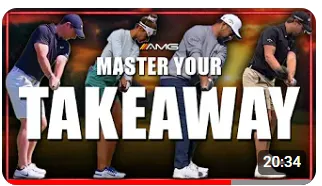
Fixing Inside Takeaways in Golf: Mastering the Lead Shoulder Movement
Golfers of all levels know how frustrating it can be to struggle with consistency in their swing. One of the most common issues we see on the course is the inside takeaway. If you're struggling with this, you're not alone—many golfers experience this problem, often without realizing it. In today's post, we'll break down what an inside takeaway is, why it happens, and, most importantly, how to fix it.
What Is an Inside Takeaway?
First things first, let’s clarify what an inside takeaway actually is. When you start your backswing and reach the point where your club shaft is parallel to the ground, an inside takeaway occurs when the club and/or your hands are positioned too much behind you. From a classic down-the-line view, this looks like the club is being pulled too far inward, setting you up for a less efficient swing.

The Mistakes That Cause It
There are a few culprits behind the dreaded outside path:
Lifting with your arms instead of turning your torso.
Pushing the grip down and pulling up with your right hand (a popular but flawed tip).
Standing up or shifting weight backward at takeaway, causing the club to lift and the plane to steepen.
Trying to “fix” it with wrist angles, which only adds more problems without solving the root issue.
The Root of the Problem: Lead Shoulder Movement
The primary culprit of an inside takeaway? It’s often the lead shoulder (your left shoulder if you’re right-handed). When your lead shoulder doesn't move correctly, it throws off the entire motion of your backswing, leading to a hoisted or steep takeaway. Let’s dive into how this happens.
When you set up the ball, your goal should be to move your lead shoulder across your body in a way that keeps your swing on- plane. However, many golfers tend to tilt their shoulders rather than rotate them, causing the shoulder to hang and the club to move inside too early. This sets off a chain reaction of compensations, making it difficult to recover for the rest of your swing.

How to Correct Your Lead Shoulder Movement
Now that you understand the problem, let’s talk about the solution. The key is to ensure your lead shoulder moves correctly—neither too much downward nor upward. Here’s a step-by-step guide to help you fix this:
Focus on a Cross-Body Movement: Imagine a cross going through your spine and shoulders. As you rotate, your lead shoulder should move across this cross, not downward or upward. This will help keep your swing on plane.
Avoid Tilting: It’s easy to think that tilting your lead shoulder downward will help you get the club on plane, but this often leads to a steep backswing. Instead, focus on a smooth rotation of your shoulders around your spine.
Practice with Feedback: Get a friend to place a finger or a club shaft near your lead shoulder. As you make your backswing, try to move your shoulder away from their hand or the shaft without making a big shift off the ball. This will give you a clear sense of how much movement is needed.
The Role of Your Wrists in the Takeaway
Once you’ve nailed the shoulder movement, it’s time to focus on your wrists. Often, golfers who struggle with an inside takeaway also have issues with their wrist action. Here’s how to ensure your wrists are working correctly:
Maintain a Slight Cup: At address, most golfers have a slight cup in their lead wrist (a small upward bend). As you start your takeaway, try to maintain this cup rather than flattening or bowing your wrist. This will help keep the club on plane.

Avoid Over-Rotating the Forearm: Your lead forearm should rotate slightly during the takeaway, but don’t overdo it. Over-rotation can lead to a shut clubface, which causes a whole new set of problems down the line.
Practice One-Handed Takeaways: To get a better feel for the correct wrist movement, try practicing your takeaway with just your lead hand on the club. This makes the club feel heavier and forces you to move your shoulder and wrist correctly.

Tying It All Together
Once you’ve worked on your lead shoulder and wrist movement, it’s time to put it all together. Remember, the first three feet of your takeaway are crucial. If you get off track here, you’ll spend the rest of your swing trying to compensate.
Here’s a drill to help you integrate these movements:
Start with Small Swings: Begin with smaller swings, focusing only on the first part of your backswing. Make sure your lead shoulder is moving correctly and your wrist maintains its cup.
Add in Speed Gradually: Once you’re comfortable with the movement, start adding in speed. Remember, don’t rush this—speed comes after you’ve mastered the movement.
Use Video Feedback: Set up a camera or your phone to record your swing from down the line and face-on angles. Review the footage to ensure your shoulder and wrist are moving correctly.
Why Feedback Matters
Finally, let’s talk about feedback. To truly ingrain these changes, you need consistent, accurate feedback. Whether it’s a coach, a friend, or a video camera, having something that can tell you if you’re doing it right is essential. Without feedback, it’s easy to fall back into old habits.
Wrapping It Up
Fixing an inside takeaway is all about mastering the basics of shoulder and wrist movement. By focusing on these key areas and using the drills provided, you’ll be well on your way to a more consistent and powerful golf swing. Remember, the key to improvement is practice, feedback, and patience. So take your time, work on these drills, and watch your game improve.
If you found this post helpful, don’t forget to check out our consistency drill designed to help you achieve a more reliable swing, every round!
👉 https://athleticmotiongolf.com/consistency

